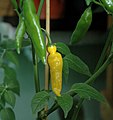Capsicum baccatum
| Capsicum baccatum | |
|---|---|

| |
| Bishop's crown fruits | |
| Scientific classification | |
| Kingdom: | |
| (unranked): | |
| (unranked): | |
| (unranked): | |
| Order: | |
| Family: | |
| Genus: | |
| Species: | C. baccatum
|
| Binomial name | |
| Capsicum baccatum | |
| Synonyms[1][2] | |
| |
Capsicum baccatum is a species of chili pepper that includes the following cultivars:
- Aji amarillo, also called amarillo chili and ají escabeche[3]
- Peppadew
- Lemon drop, ají limon[3] (not to be confused with ají limo, a Capsicum chinense cultivar
- Bishop's crown
- Brazilian Starfish
- Wild Baccatum
Origins and distribution
The C. baccatum species, particularly the Ají amarillo chili, has its origins in ancient Peru. It is typically associated with Peruvian cuisine, and is considered part of its condiment trinity together with red onion and cilantro. Aji amarillo literally means yellow chili; however, the yellow color appears when cooked, as the mature pods are bright orange.
The wild baccatum species (C. baccatum var. pendulum) is the domesticated pepper of choice of Bolivia, Ecuador, Peru and Chile[4]
Etymology: Aji is the Caribbean word for chili and/or peppers. The Spanish colonizers spread the term to much of South America.
Description
-
Flower
-
Cultivar 'Lemon Drop'
Pepper varieties in the C. baccatum species have white or cream colored flowers, and typically have a green or gold corolla. The flowers are either insect or self-pollinated. The fruit pods of the baccatum species have been cultivated into a wide variety of shapes and sizes, unlike other capsicum species, which tend to have a characteristic shape. The pods typically hang down, unlike a Capsicum frutescens plant, and can have a citrus or fruity flavor.
Culinary usage

Yellow ají is one of the ingredients of Peruvian cuisine and Bolivian cuisine. It is used as a condiment, especially in many dishes and sauces. In Peru the chilis are mostly used fresh, and in Bolivia dried and ground. Common dishes with aji "amarillo" are the Peruvian stew Aji de Gallina ("Hen Chili"), Huancaina sauce and the Bolivian Fricase Paceno, among others. In Ecuadorian cuisine, Aji amarillo, onion, and lemon juice (amongst others) are served in a separate bowl with many meals as an optional additive.
In Colombian cuisine and Ecuadorian cuisine, ají (sauce) is also a common condiment.
Use by Moche

The Moche culture often represented fruits and vegetables in their art, including Ají amarillo peppers.[5]
See also
References
- ^ "The Plant List".
- ^ "USDA GRIN Taxonomy".
- ^ a b Dave DeWitt and Paul W. Bosland (2009). The Complete Pepper Book: A Gardener's Guide to Choosing, Growing, Preserving, and Cooking. Timber Press. ISBN 978-0881929201.
- ^ "Genetic diversity in Capsicum baccatum is significantly influenced by its ecogeographical distribution". BMC Genetics. 13 (68). 2012. doi:10.1186/1471-2156-13-68.
{{cite journal}}:|access-date=requires|url=(help)CS1 maint: unflagged free DOI (link) - ^ Berrin, Katherine & Larco Museum. The Spirit of Ancient Peru:Treasures from the Museo Arqueológico Rafael Larco Herrera. New York: Thames and Hudson, 1997.


